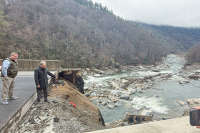Origin of WCU white squirrel a mystery
A rare sighting of a white squirrel at Western Carolina University has workers there abuzz.
The squirrel has been spotted a number of times, and is clearly not albino because it doesn’t have pink eyes, said Roger Turk, grounds superintendent for WCU’s facilities management department.
There is a large population of 1,500 or so white squirrels in Brevard, a unique phenomenon intrinsic to that area. Sightings are unusual outside Transylvania County, although not entirely unheard of. Whether the white squirrel in Cullowhee is an offshoot of that population, or simply a variation of the Eastern Gray Squirrel living at WCU, isn’t known.
Jim Costa, a WCU biology professor and director of the Highlands Biological Station, said it’s possible the white squirrel strain from Brevard migrated to Cullowhee — but it might also be a separate strain that evolved on its own.
“Squirrels disperse over the generations, but the one sighted on campus did not necessarily originate in the Brevard population — it may have, or it may be a color variant that arose recently in the local population,” said Costa.
A couple of years ago, Costa saw a white squirrel between Cashiers and Highlands, but that’s the only time he’s seen one very far from Brevard.
“As you can imagine there’s a pretty stiff penalty for being a white squirrel in an area with loads of hawks and such, but they manage to hold their own in Brevard,” Costa said.
In Brevard, the white squirrels have a distinctive black cap and black saddle that WCU employees aren’t reporting seeing on their white squirrel.
“The markings are noticeable,” said Madrid Zimmerman, director of the Brevard Main Street program.
Regardless of its origins, the sighting at WCU has been exciting for those lucky enough to catch a glimpse. The white squirrel has been seen around the baseball fields and the greenhouse and at least once, by an off-campus witness, near St. David’s Episcopal Church behind the Ramsey Center.
WCU’s Turk hasn’t seen the creature himself, but several of his employees have — and they’ve gotten good, long looks at the animal, he said.
“It’s been seen six to eight times,” Turk said. “So far they’ve only seen the one.”
Lynn Warner of Heart of Brevard said it isn’t that unusual for them to field calls from excited individuals who’ve seen white squirrels outside of Brevard.
“People call and say, ‘I’ve seen one,’” Warner said. “And they’re fascinated.”
But when you’ve got as many of the creatures as Brevard does, it’s hard to overly impress the workers in that town.
The white squirrel population in Brevard, according to annual white squirrel counts, is growing larger, Warner said. They currently make up a significant percent of the squirrel population there; some biologists believe the white color might one day dominate over gray-colored squirrels, she said.
The 2010 count recorded 37.1 percent white-versus-gray, the highest yet on record, in Brevard, well above the 14-year average of 28.1 percent, according to Brevard’s White Squirrel Research Institute.
One of the prime viewing sites for white squirrels is Brevard College. The town and college are so proud of their white squirrels Brevard holds an annual White Squirrel Festival and a Squirrel Box Derby.
Brevard residents commonly — and happily — put out birdseed for the white squirrels, Zimmerman said, but they try to discourage the gray squirrels from feasting.
“We all brake for white squirrels. We think twice for gray squirrels,” she said, only seemingly in semi-jest.
The story behind the population in Brevard seems a mixture of fact and lore.
According to history, the white squirrels there originated from a circus truck that overturned in 1949 near the home of a man in Madison, Fla. (this according to www.whitesquirrels.com). He gave two white squirrels to another individual, who bequeathed them on Barbara Mull, a longtime resident of Brevard.
She kept them inside and hoped they might breed, but they didn’t. In 1951, one of the white squirrels escaped outdoors. Not long afterwards, Barbara’s father let the other white squirrel free.
Before long, white squirrels were seen about Brevard. And now, at WCU.
Brevard takes its squirrels seriously
A town ordinance states: “The entire area embraced within the corporate limits of the city is hereby designated as a sanctuary for all species of squirrel (family Sciuriadae), and in particular the Brevard White Squirrel. It shall be unlawful for any person to hunt, kill, trap, or otherwise take any protected squirrels within the city by this section.”





